| ................ to Part: 1 2| 4 5 |
MARSHFIELD SUN ANNUAL JAN. 1901 SPECIAL EDITION Part 3 Compilation copyright (c) 2005 by Marilee Miller NO COPYING OR DISTRIBUTION of this document without permission.. Text-only version, free copy, please go back to Sun Annual Part 1 Part 3. #22= Capt Edwards Steamer Alert #23= J. M. Upton #24= Match Factory #25= Coos Bay Railroad Co. #26= Judge L. Harlocker. #27= Assessor J. S. Lawrence #28= Tupper House, Bandon #29= County Clerk L. H. Hazard #30= Myrtle Point Hotel #31= Attorney W. U. Douglas #32= Steamer Dispatch #33= North's Creamery #34= S. B. Cathcart #35= Wm. B. Curtis ///// |
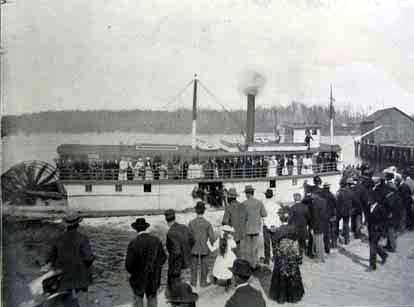
| ............. |
______________ CAPT. CHARLES E. EDWARDS ______ There are many requisites for success in life, but energy and perseverance count for most, and the man with the best "rustling" abilities stands a much better chance of winning golden sheckels than one without this qualification. Capt. Edwards, the subject of this sketch, has proved himself to be a "rustler" of the first class. Chas. E. Edwards was born in Miama [sic] county, Indiana, in 1853. When he was but one year old his parents removed to Wisconsin, and later to northern Kansas. In 1871 Mr. Edwards came to the Pacific coast and accepted a position on Mr. John Rooney's sugar ranch, and later became foreman and remained in that position for three years. In 1875 he came to Coos county, and shortly after his arrival accepted a position as ships [sic] carpenter, and assisted in building the steamer, "Little Annie" which was launched in November, 1876, at which time he accepted a position as one of her deck hands, and later became engineer and in the fall of 1878 master, which position he held until 1883, when he became engaged in the furniture business at Myrtle Point. In 1886 he disposed of his stock and became interested with Messrs. Burk & Rohm, under the firm name of Edwards, Burk & Co. In 1888 he sold his interest in this establishment, and, in connection with H. D. Dalmas, built the first sawmill at Myrtle Point. Disposing of his interests in 1891, he accepted a position in the saw mill at Parkersburg, and later at Prosper, where he remained until 1893, when he became engineer on the steam tug Katie Cook, at Rogue River, where he took a contract to move Gold Beach to Wedderburn. In December, 1895, Capt. Edwards took a long lease of the steamer Alert, which makes a daily round trip between Alleghany, at the head of navigation on the Coos river, and Marshfield. In 1884 he was elected county commissioner, and re-elected in 1886. Capt. Edwards has always been an advocate of good roadways and it was mostly due to his efforts that the wagon road between Alleghany, Coos county, and Elkton, in Douglas county, was surveyed. This road means a great deal to Marshfield and the upper Coos river, as it gives a much shorter and easier route to and from the country. Capt. Edwards was married in March, 1880, to Miss Mary C. Roberts, of Myrtle Point, and has an interesting family of three girls and one boy. Capt. Edwards affiliates with the Masonic order. |
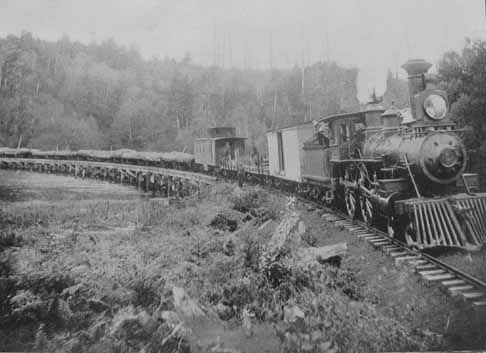
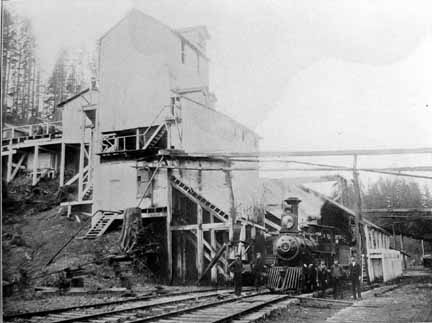
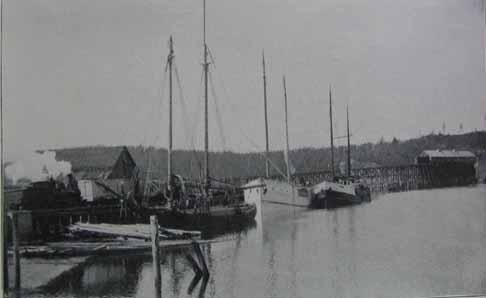
| xxxxx |
________________ THE C. B. R. & E. R. R. & N. CO. _________ Traverses a Country Rich in Mineral and Natural Wealth - Early Extension to Roseburg. ______ The C. B. R. & E. R. R. & N. Co. road has been completed and is operated from its western terminus at Marshfield, on Coos Bay. The road runs in a southerly direction following the west shore of Isthmus Slough and skirting the eastern slope of a series of hills, underlaid with veins of lignite coal, for a distance of eight miles; at this point the ascent of the watershed dividing the Coquille and Coos bay basins begins and is continued by an easy grade for a distance of two miles, where the summit of the divide is reached and the descent to the Coquille Valley commences. This fertile section of Coos county is then traversed for a distance of 18 miles, passing through the city of Coquille and an extensive range of grazing country that is fast becoming the most prominent in the state in the line of dairy products, to Myrtle Point, a thriving little city at the head of navigation on the Coquille river, and which is the present terminus of the road. From Myrtle Point eastward no work has been performed, other than preliminary surveys up the Middle and North Fork of the Coquille river and over the Coast range of mountains through the Camas and Looking Glass valleys to the city of Roseburg, 64 miles distant from Marshfield. The country east of Myrtle Point is broken and mountainous, though in great part well adapted for sheep and cattle raising, large bodies of timber are also to be found in different localities, and occasional fields of lignite coal. The principle commodities exported over the road are coal, lumber, ship knees, ship spars, live stock, wool, potatoes, apples, and dairy products. The equipment of the road consists of two locomotives, one passenger coach, one caboose, and 62 freight and logging cars. The terminal facilities at Marshfield, consisting of large coal bunkers, extensive wharves and warehouses, which are well adapted for the handling of large quantities of coal, lumber, and miscellaneous freight directly from the cars to ocean vessels. Here, also, are located the company's machine shop, round house and car shops for the building and repair of railroad equipment. In the car shops is found the latest improved wood-working machinery especially adapted for railroad work, which enables the company to do all of their own construction of coaches, box, flat, coal, and logging cars in a manner equal to those of trans-continental lines. The machine shop has all the appurtenances necessary for the repairing of locomotives and mining machinery, and a large blacksmith shop in connection, supplied with a powerful steam hammer, a blower and aside from the forges and furnaces, all of which enables them to do heavy work. The Management. This road has been operated since December 18, 1899, by W.S. Chandler as receiver for the U.S. Court pending a foreclosure suit of the Farmer's Loan & Trust Company, of New York, in the interest of the bondholders, the J. D. Spreckels and Brothers Company of San Francisco. This latter company's interests in Coos County amount to over a million dollars and as they are everywhere known for their progressive business spirit, it is safe to say that when the present litigation is wound up that they will reorganize, and there will be fair prospects for the early extension of the road to connect with the Southern Pacific at Roseburg. Improvements. On assuming charge of the road, Manager Chandler found things in a very dilapidated condition, but he has given his time and attention to the straightening out and systematizing of affairs. Bridges have been rebuilt, new ties installed where necessary, and thousands of tons of ballast [illegible; = placed?] on the road, which now makes the roadbed in perfect condition. Besides giving his attention to general repair work wherever needed, Manager Chandler has put in several new and important switches along the line which has greatly facilitated the handling of trains; a new and modern freight and passenger depot has also been constructed at Coquille City, the county seat of Coos county and situated along the line of the road. Freight and passenger traffic over the road has been an item of interest to Mr. Chandler, who has by his courteous ways and reasonable dealings increased the traffic of the road to a height never dreamed of by the former operators, and placed the property on a paying basis - all of the rolling stock being necessarily in use to handle the business. Car Building. In order to meet demands of the increasing business of the road another passenger coach is to be added to the list of rolling stock in the near future, the fittings for same having already been ordered from the East and the car will be built in the company shops in Marshfield. Spur Lines. Connecting with the main line of the railroad are two spur lines of a combined length of five miles and running to the Klondike and Beaver Hill coal mines. Along these lines, as on the main road, are situated numerous logging camps that find rail transportation to the sawmill. Beaver Hill mines. At Beaver Hill is [sic] located the coal mines of the same name, which are being developed on the "shute [sic] and pillar" system, which is the only practicable method of mining and extracting this coal, owing to the soft and friable nature of the over and under lying strata. Equipment in the way of mining machinery can be found here equal to any mining camp on the coast. There is also a coal washer of modern pattern, a cut of which appears elsewhere in this issue. = |
| (pg 14-15) # 26 |
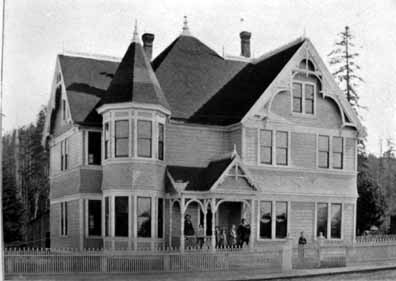
| ...xxxx... |
_________________ JUDGE L. HARLOCKER _____ But few, if any, stand higher socially or morally in the estimation of his friend [sic] and neighbors in the commonwealth than the subject of this sketch. His name is a synonym for all that is true and honorable in a man, fellow citizen and officer. L. Harlocker was born July 6, 1848, in Franklin county, Ohio. When but two years old his father died and his mother removed to Grant county, Wisconsin. Here the subject of this sketch remained until 1865, when he enlisted in the Forty-seventh Infantry of Wisconsin. Was mustered out in the latter part of August in the same year. He then joined his mother, who had removed to Charles City, Iowa, and again took up his studies, entering the public schools of Charles City, where he remained until 1869, at which time he went to California and accepted a position on a stock ranch in Sonoma county, remaining there until 1871, when he removed to Oregon, locating in Coos county, where he bought a farm and one year later took up a homestead. Mr. Harlocker then followed farming and logging for the next ten years. In 1882 he was elected county assessor of Coos county on the Republican ticket and re-elected in 1884. In 1886 he was elected sheriff. In 1890 Mr. Harlocker removed to Coquille City and opened a real estate office. In October he became deputy post master of Coquille, and on the resignation of Postmaster J. H. Nosler, was appointed postmaster, which position he held for four years. In 1896 he accepted the position of depot agent. In 1898 Mr. Harlocker again received the appointment of post master at Coquille, which position he held until June, 1900, when he was elected county judge. Mr. Harlocker was married August, 1889, to Miss Fannie I. Coke, of Coos county, and has an interesting family of five children, three boys and two girls. He is a member of the I. O. O. F. Judge Harlocker is a firm believer in Coos county and especially of Coquille City, and shows his belief in the future greatness of that city by erecting the finest home in the county, an engraving of which appears in this issue. |
| (pg.15)xx #27 |
____________ J. S. LAWRENCE ______ Few persons occupy a higher position in the [illegible; = estimation of the people of Coos county?] than does J. S. Lawrence. His reputation for integrity, and all other commendable qualities of heart and mind, constitute established credentials of which any one may well feel proud. As a public officer Mr. Lawrence is not only courteous and affable, but is always willing to lend a helping hand to any deserving enterprise, and has always taken a great interest in the welfare of Coos county. Mr. Lawrence was born on a farm in St. Francis county, Mo., in 1852. He received his education by attending the Libertyville public schools during the months of winter. In summer he was busy assisting his father on the farm. In 1877 Mr. Lawrence removed to Northwest Texas and became engaged in the farming and lumber business, which he followed until 1885, at which time he concluded to remove to the far West, and in the fall of 1885 he located in Coquille, Coos county, Oregon. Mr. Lawrence had been in Coquille but a short time before he accepted a position at the Lyons' mill at trimming and tallying, which position he held for twelve years. In 1898 Mr. Lawrence was elected assessor on the Democratic ticked by 328 majority. Mr. Lawrence has filled the position not only with credit to himself, but also with entire satisfaction to his constituents, which fact is proven by the phenomenal plurality (515) he received at his re-election in 1900 over his Republican opponent. Mr. Lawrence was married April, 1876, to Miss Anna McClintock, of St. Francis county, Mo., and has an interesting family of four children, the eldest being B. F. Lawrence, who is at present engaged in the newspaper field at Portland, Oregon. |
| (pg.13,15) # 28 |
____________ TUPPER HOUSE. _______ This long-established and well-known public house, situated on the main street of Bandon, has always been ranked among the first-class hotels in the interior of the county, but never since it was first opened has it enjoyed a better reputation in all respects than at the present time. This fact speaks volumes for the superior management of the genial and obliging landlord, Robt. E. Lee Bedillion, who is ever attentive to his guests and who leaves nothing undone that would add to their comfort and pleasure. The Tupper House is a large, two-story structure, containing upwards of 40 rooms, and is complete in all departments. An excellent table is set, all cooking and other preparation of food being done by white labor. No Chinese are employed in any capacity, which very commendable feature is duly appreciated by those who stop at the house or occasionally take their meals there. The dining room is large, light and well ventilated, the office is roomy and well arranged, having all the customary conveniences, while the barroom and billiard parlor are equipped and furnished in a neat manner. Nicely furnished and commodious parlors are found on the second floor. The sleeping rooms are all airy and well lighted. Mr. Bedillion took charge of the Tupper House June 26, 1900, since which time he has made many improvements, foremost of which is the table board, and refurnishing the sleeping rooms. Lately the office, dining room, bedrooms and parlor have been thoroughly overhauled, papered and painted, and everything put in excellent repair. The hotel as now furnished is one of the finest in the county, and the landlord is a generous and fair- dealing gentleman, who well deserves the splendid patronage his house is receiving. In the Tupper House is located the long-distance telephone office, and stages for all points make calls previous to their departure. |
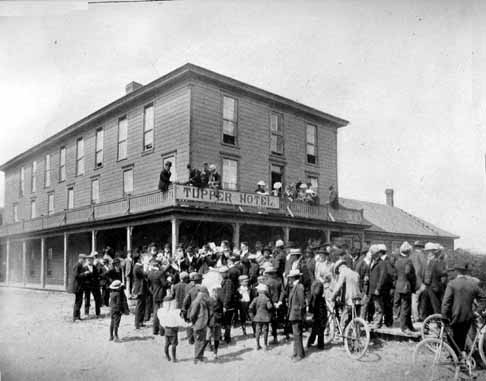
| (pg. 16)xx #29 |
_______________ L. H. HAZARD _____ The present efficient clerk of Coos county is a man who stands high among his constituents, and is the fortunate possessor of a host of warm personal friends, who, in admiration of his numerous sterling qualities, would make almost any sacrifice to enhance his success. He was born in Johnson county, Iowa, November 3, 1867. After completing his education in the public schools of Iowa, he joined his father, S. H. Hazard, at Empire City, Coos county, Oregon, and two years later received the appointment of deputy postmaster under J. M. Arrington at Marshfield, remaining in this position until June, 1888. He then accepted a clerical position with the Southern Oregon Company. Here he remained for the next four years, when he resigned to accept the position of storekeeper in the U. S. commissary department. Two years later Mr. Hazard became bookkeeper for H. Sengstacken at Marshfield. In June, 1896, Mr. Hazard accepted the deputy county clerkship under Ed. Rackliff [sic], and on Mr. Rackliff resigning in December, 1889, was appointed county clerk, and at the next regular election, June, 1900, was elected to fill the same position. Mr. Hazard was married on August 12, 1896, to Miss Mabel E. Hacker, of Empire City. They have one child, a boy. |
| (pg.16,18) #30 |
_______________ MYRTLE POINT HOTEL _____ The American people are fast becoming great patrons of the hotel. No matter whether they travel much or little, they love to enjoy the freedom of a well-kept hostlery [sic]. The home residents can enjoy the dinner, supper, or their Sunday meals with as keen a relish as can the traveler or tourist. This change is brought about by the fact that hotels are now made the model of comfort, and to be the landlord of a successful house means to be a man of experience and a close observer of people. Relative to these remarks, we would make mention of Kennedy H. Hanson, landlord at the Myrtle Point Hotel, the most popular hotel in the city. Mr. Hanson took charge of this hotel August 10, 1900, since which time he has made many improvements, amongst which may be mentioned the very great improvement in the table service, which today is considered equal to any in the county. He also has a fine bathroom, with hot and cold water, which is free to his guests. The house is well-lighted and scrupulously clean, and for the accomuation [sic; = accommodation] of the traveling men he has large sample rooms which are well heated during the winter months. You can book from this hotel on any of the stage lines. An engraving of this hotel appears in this issue. Kennedy H. Hansen was born in Council Bluffs, Iowa, on the 26th day of August, 1858. He remained there until 1884, when he removed to Oregon, locating in Coos county, and for six years taught school. In June,1894, he was elected assessor and in 1896 re-elected. Mr. Hansen was married the 28th of March, 1886, to Miss Ida Jackson, of California. They have two children living. Mr. Hansen still owns a fine ranch a few miles from Myrtle Point, from which he is able to get fresh vegetables and fruits for his hotel. He affiliates with the Masons. |
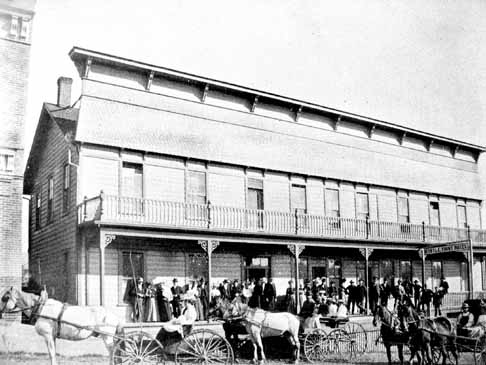
| (pg.16)xx # 31 |
_______________ W. U. DOUGLAS _____ Few persons occupy a higher position in the estimation of the people of Coos county than does W. U. Douglas, of Marshfield. His reputation for integrity and for all other commendable qualities of heart and mind, constitute established credentials of which anyone might well be proud. Mr. Douglas came to Marshfield some ten years ago, during which time he has been engaged in various enterprises, but for the past two years has devoted his entire time to the practice of law. His offices are pleasantly located in the Smith-Sengstacken building. |
| (pg.12)xx # 32 |
______________ [Steamer Dispatch] |

| (pg.12,16) # 33 |
_______________ T. A. NORTH _____ There is no man in Coos county that has done as much for the dairy industry as the subject of this sketch. In fact, it is mostly due to his efforts in this direction that Coos county's butter is today so well and favorably known throughout California and Oregon. Mr. North is more than ordinarily well versed in the dairy business, having devoted the past 24 years of his life to it, during which time he has not only had practical experience throughout the different states where this industry flourishes, but has made a thorough study of the climate, soil and grasses that go to make a first-class dairy country, and says that Coos county, Oregon, is the very finest country in the United States for the dairy business. This is a broad statement but Mr. North has proven that he believes what he says by establishing one of the best equipped creameries in the state. Mr. North has shown good judgment in the site chosen for his creamery, situated on the bank of the Coquille river, about midway between Coquille City and Bandon. He is thereby able to accommodate the farmers both on the upper and lower part of the river. By his creamery is one of the largest mountain springs in the county, the water from which is icy cold and as clear as crystal. Mr. North has piped this water into his creamery, and claims that he is able to obtain better results by using this cold water for churning purposes than ever before. His creamery has a capacity of 800 pounds n hour, and is equipped with all of the latest modern improvements. He has named it the Mountain Springs Dairy, and all butter bearing that label brings the highest market price. His produce is all shipped to San Francisco. An engraving of his creamery appears in this issue. |
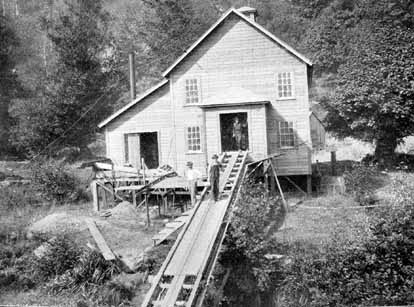
| (pg. 18)xx # 34 |
_________________ S. B. CATHCART. _____ Prominent among surveyors and civil engineers of this state is the name of S. B. Cathcart, who was born in Orange county, Indiana, in 1842. When but eleven years old he, in company with his parents, made the trip across the plains to Oregon, locating in Douglas county, where he acquired his preliminary education in the public schools. In 1871 he removed to Coos county, and settled on north Coos river, and in his bachelor's cabin continued the study of civil engineering for two years. In 1873 he received the appointment of U. S. deputy mineral surveyor for the sixth mineral district (Coos and Curry counties). In 1874 Mr. Cathcart was elected county surveyor and was re-elected in 1886, '88, '92, '94, '96, '98, and 1900. Mr. Cathcart served one year in Company A First Oregon Calvary, and for fifteen years was a member of Baker Post No. 8 G. A. R. Mr. Cathcart was married on July 15, 1879, to Miss Dora A. Landreth, of Coos river. In 1890 they removed to Marshfield, where they still reside. |
| (pg. 18)xx #35 |
______________ WM. B. CURTIS _____ As a hamlet grows into a village and then into a town its various offices should be filled by capable men. Among these the position of councilman is one that requires a man of more than ordinary ability to discharge its duties, and to fill it to the satisfaction of his constituents its incumbent must be a man of [microfilm printout illegible] executive ability. Wm. B. Curtis, the subject of this sketch, has proven to be the right man in the right place and as a public officer he is active and farsighted, as well as affable, gentlemanly, and approachable. Mr. Curtis was born in Maine, August 19, [microfilm printout illegible]. His secondary education was obtained in the public schools and later in the E. M. C. Seminary at Bucksport, Maine. After leaving school Mr. Curtis followed [illegible] four years. In 1874 he came to California, where he was employed on a fruit ranch until 1875, when he decided to come to Oregon, and in 1878 he located in Coos county and one year later accepted the position of hotel clerk at the Blanco hotel, at Marshfield, which position he held until October, 1898 [printout not clear], at which time he received the appointment of post master for Marshfield, which position he still holds. In 1897, Mr. Curtis was elected a member of the city council or "town board," as it [printout unclear = is?] termed in Marshfield, and in 1899 was re-elected to the same position. Mr. Curtis was married to Miss R. Hirst of Marshfield. They have an interesting family of three children, two boys and one girl. Mr. Curtis affiliates with the I. O. O. F., K. of P., and A. O. U. W. |